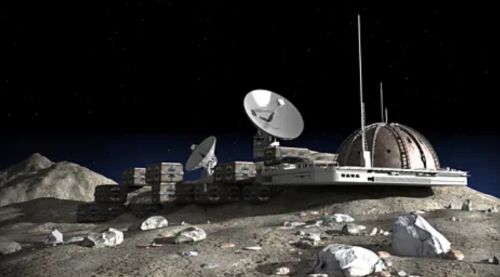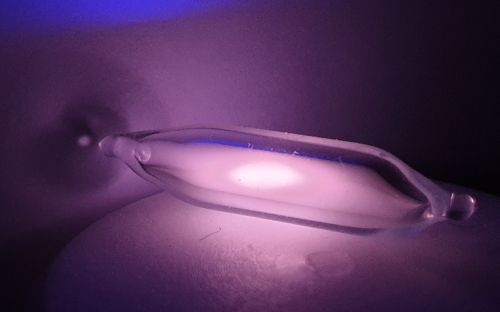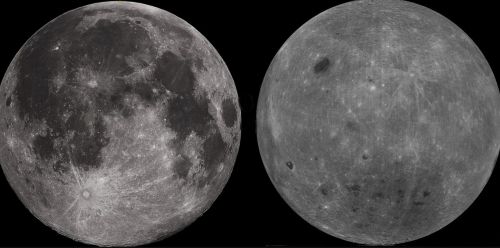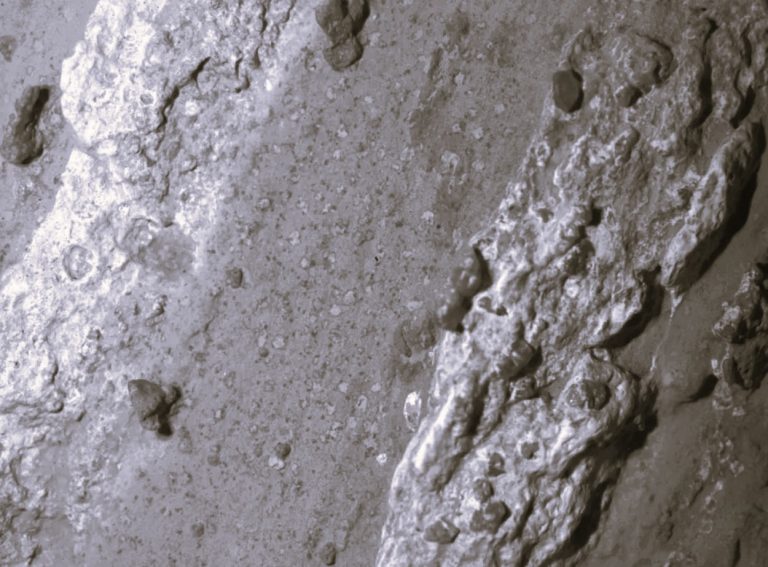

In environments where sunlight is weak or intermittent, nuclear power is the only realistic option for sustained human presence.

By Matthew A. McIntosh
Public Historian
Brewminate
Why the Urgency?
A Sudden Acceleration in the Moon’s Energy Race
When NASA quietly issued its new directive to industry in August, it was more than a scheduling adjustment. It was a declaration that the United States intends to power its lunar future not with slow, incremental steps, but with the decisive hum of a nuclear reactor planted firmly in the Moon’s regolith by 2030. The target is no longer a modest 40-kilowatt prototype. The bar is set at 100 kW, enough to run a small lunar base through the Moon’s frigid two-week night, when the Sun’s energy disappears and solar arrays fall silent.
The announcement caught even seasoned space policy watchers off guard. For years, nuclear surface power had been part of NASA’s long-range planning, nestled in presentations about “sustainability” and “next generation exploration.” But timetables tended to drift. Funding ebbed and flowed. Now the tone has shifted from patient ambition to urgent necessity.
Industry leaders, from aerospace primes to nuclear specialists, have welcomed the challenge. Lockheed Martin’s concept art has already made its rounds — towering arrays of radiator panels, compact reactor cores, and modular construction designed to be landed in a single heavy-lift mission. They speak of aggressive but achievable goals. Behind the optimism lies a clear motive: whoever establishes dependable, round-the-clock energy on the Moon will shape the rules for everything that follows.
Power Beyond the Sunlight
The Moon is a hostile landlord. Temperatures swing from blistering highs during the lunar day to lows that plunge past minus 200 degrees Celsius at night. Those night spans are not hours, but 14 Earth days of darkness. For the Apollo program, this was a footnote, astronauts stayed only a few days and never needed to survive a lunar night. For the Artemis era, it is the central problem.
Solar power, for all its appeal, cannot bridge the gap without massive battery storage or complex relay systems. A nuclear fission surface power system offers steady, weather-independent output, free from the vagaries of lunar dust storms or polar shadows. NASA’s engineers envision a design that could run for a decade without refueling, enough to support habitats, mining operations, and scientific stations.
There are also symbolic stakes. A working lunar reactor would not only extend human presence on the Moon but would mark the first permanent, industrial-scale use of nuclear power off Earth. It would be a technological and political statement in equal measure.
The Geopolitical Undercurrent

In public, NASA frames the push as a natural step in exploration. Behind closed doors, the language is different. China has signaled its intention to deploy its own surface power system, possibly in partnership with Russia, within the same decade. Officials in Washington worry about “exclusion zones,” operational areas claimed under the guise of safety that could limit access for others. A robust U.S. power grid on the Moon would make it harder for rivals to dictate the terms of presence.
This is not entirely Cold War redux. The competition is more diffuse, tied to resource prospects like helium-3, rare earth metals, and water ice deposits in the permanently shadowed craters of the lunar poles. Power systems are the precondition for exploiting any of it. A nation that controls the power may indirectly control the pace and direction of lunar development.
Industry as Partner and Stakeholder
Unlike the Apollo era, when NASA built nearly everything in-house, the Artemis architecture leans heavily on commercial partners. The nuclear directive is no exception. Contracts will likely involve consortia of aerospace giants, specialized reactor firms, and space-rated systems engineers. The 2022 awards for early reactor concepts went to teams led by Lockheed Martin, Westinghouse, and IX, with each pursuing different cooling, shielding, and modular assembly strategies.
The acceleration to 100 kW changes the equation. It will require not only proof-of-concept units, but full-scale systems able to withstand radiation, micrometeoroid impacts, and the mechanical stresses of launch and landing. It is an engineering puzzle with as many political variables as technical ones.
The Long View and the Unknowns
NASA’s timeline is bold. Developing a space-rated nuclear reactor is not like adapting an Earth-based design. Weight, shielding, and heat rejection systems must be tuned for an environment without air or convection. Safety concerns extend to launch, even with robust containment, the idea of lofting fissile material into space will draw scrutiny from environmental groups and some members of Congress.
Yet, the pace suggests that hesitation is no longer an option. The 2030 target sits at the edge of the Artemis program’s planning horizon, a point at which lunar bases are projected to shift from demonstration outposts to semi-permanent hubs. Without reliable power, those hubs remain concept art.
What remains uncertain is whether this acceleration will outpace not just foreign competitors, but the institutional inertia that has slowed past space infrastructure projects. NASA’s history is littered with ambitious power concepts that never reached flight. The Moon, indifferent to deadlines, will test whether this time is different.
If the 100 kW reactor makes it to the lunar surface within five years of its target date, it will signal more than a technological triumph. It will mean that human civilization has taken a deliberate step toward energy independence beyond Earth, a milestone with implications that will echo far longer than any one mission.
The Engineering Hurdles of Powering the Moon with Nuclear Fission
Why the Moon Is a Different Problem Entirely

Designing a nuclear reactor for the Moon is not simply a matter of shrinking a terrestrial model. Earth’s reactors benefit from an atmosphere that helps dissipate heat, gravity that keeps coolant systems stable, and decades of infrastructure to transport and store fuel. The Moon strips away all of that. It offers no air, only one-sixth of Earth’s gravity, and environmental extremes that push machinery to its limits.
A space-rated fission system has to operate in a vacuum where convection, one of the primary means of heat transfer on Earth, does not exist. Engineers must rely solely on conduction and radiation to move heat away from the reactor core. That means large, lightweight radiator panels, often many times the surface area of the core itself, to bleed off waste heat into space.
Shielding Against a Hostile Environment
Radiation protection is another defining challenge. On Earth, water or concrete barriers can be used to absorb radiation. On the Moon, those materials are heavy, costly to launch, and would take up valuable payload capacity. Designers are exploring alternatives such as regolith shielding, which would involve covering the reactor with lunar soil after installation.
The problem is compounded by the need to shield not only astronauts, but also sensitive electronics in nearby habitats or processing plants. High-energy particles from the reactor could degrade solar arrays, weaken structural materials, or cause data corruption in computing systems.
Fuel and Launch Safety
No matter how well-engineered, the public and political optics of launching fissile material into space require extreme caution. NASA has experience with radioisotope thermoelectric generators (RTGs), which use plutonium-238, but a full-scale fission reactor demands uranium fuel enriched to levels that would make it highly controlled under international safeguards.
To mitigate risk, reactor designs often keep the core subcritical, unable to sustain a chain reaction, until after landing. The control systems that initiate fission would be activated only once the unit is safely deployed on the lunar surface. Even so, the idea of lofting nuclear fuel atop a launch vehicle is guaranteed to draw scrutiny.
Longevity and Maintenance
The goal is a reactor that can run autonomously for a decade without human maintenance. That means robust fault detection, redundancy in coolant loops and control rods, and a power conversion system that can withstand constant thermal cycling as the Moon’s surface environment changes.
In practice, that might involve Stirling engines, Brayton-cycle turbines, or thermoelectric modules, each with their own trade-offs in efficiency, mechanical complexity, and durability. The choice will affect not just the reactor’s size, but also how easily it can be scaled for larger operations in the future.
Conclusion: Why It Matters Beyond the Moon
Although the current focus is on lunar exploration, a successful fission surface power system could be adapted for Mars, deep-space stations, or even asteroid mining bases. In environments where sunlight is weak or intermittent, nuclear power is the only realistic option for sustained human presence. If the United States can demonstrate a working 100 kW lunar reactor by 2030, it would set a precedent for planetary-scale energy independence. It would also open the door for commercial entities to build and operate their own space-based power systems, blurring the line between government-led exploration and private-sector expansion into the solar system.
Originally published by Brewminate, 08.13.2025, under the terms of a Creative Commons Attribution-NonCommercial-NoDerivatives 4.0 International license.


